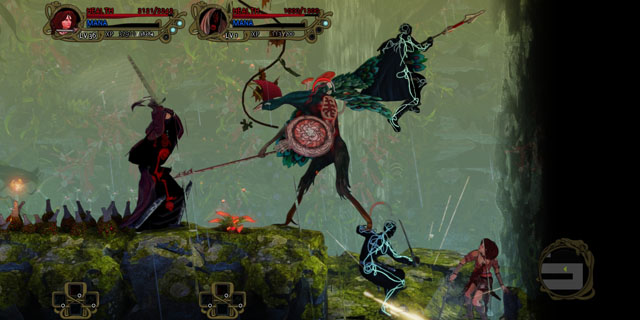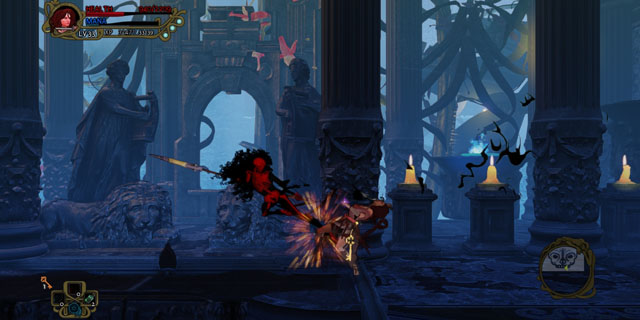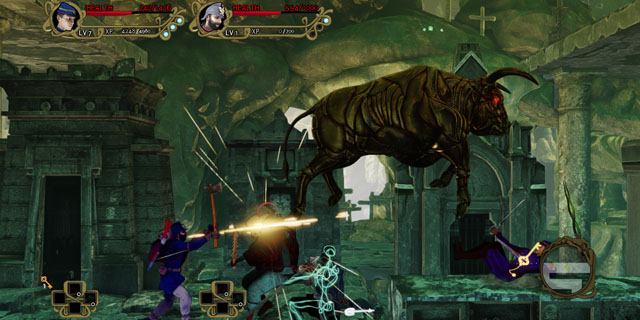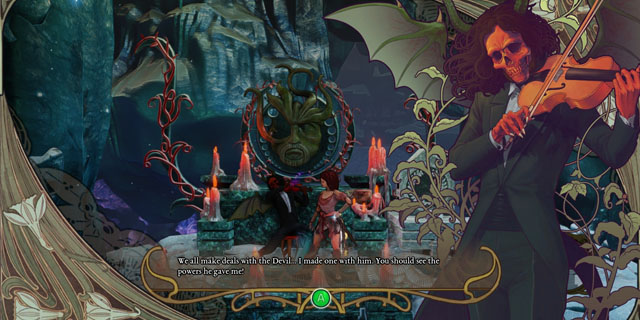
I want to like Abyss Odyssey. It’s chock-full of concepts that appeal to me, and if you asked me to review the design document instead of the finished product, it’d get top marks. In historical Chile, a warlock has descended into the abyss and taken a nap. That’s fine, as warlocks are weird guys, and they can sleep where they want. The unfortunate thing is that the warlock has a vivid imagination, and the abyss is causing his nightmares to come to life and terrorize the people on the surface. Your job: get to the bottom of the abyss, kill the warlock and save the people of Chile from being gored and eaten by horrible monsters.
This is a great setup for a game. Unfortunately, the controls aren’t up to the task. Everything feels slow instead of deliberate, jumping often doesn’t work because characters are slow to turn the direction being pushed, and when you do manage to complete a jump and start attacking the beast above you, your motions look stilted and separate instead of flowing together to form a stylish combo. You can still progress, but instead of channeling Devil May Cry or God of War and taking out foes by discovering their weakness and using the best attack for the job, it’s safest to pin them in a corner and execute the same four-hit combo over and over again.

When multiple enemies show up, you fall in combat and assume control of one of the soldiers guarding the abyss’ entrance on the surface. He isn’t as strong as your main character, and his chief duty is to get to an altar and bring your chosen character back to life. It’s an interesting mechanic that manages to cheat death a good portion of the time, and it casts the roguelike features in a new light, because death isn’t necessarily permanent. While death does end the current run, Abyss Odyssey is more rogue-light that roguelike. Gold, combat moves and experience all carry over while the abyss reorganizes itself.
Runs are singular, however. Each time you quit, you’re giving up on your current attempt. Ironman saves would have worked well here (as they do in all roguelikes), as we don’t all have two hours to set aside at a time. If you do manage to clear the game (and it can be done in that two-hour window), you’re helping the community to unlock new features like additional playable characters. That’s a great concept, and I wish that more games implemented similar features to give their ware increased longevity for solo players.
There are three characters to choose from. Each has a set of special attacks that go with their individual weapons (long sword, two-handed sword and polearm) which make them all feel like more than simple re-skins of the default character Katrien. Each character has a set of six specials to find and their own unique set of combat moves that really showcase the fighting game influence in the combat. Regardless of distinctiveness of move sets, every character is slow to control. It almost feels like there is input lag built into the game, and I can’t figure out why. Special moves are executed the same way, regardless of character (direction + Y on the 360 pad), and you’ll want to use them quite a bit because their successful use charges up the mana bar. When that bar is full, you can initiate a super-powerful attack that does a ton of damage and has another interesting use: it causes enemies to drop their souls.

When you collect a soul, you have the option to press down on the D-pad to become that enemy. Basic gameplay doesn’t change, but when you’re a giant bull, your combat moves look appropriate to your new form and, best yet, when the transformed beast falls, you simply revert back to your original form and continue fighting. Each enemy is fully playable, with the difference being a preset three-special repertoire in opposition to the six specials of which you choose three for hero characters. This is great for getting through tough areas or doing significant damage to difficult boss creatures.
Competitive play turns Abyss Odyssey into Chilean Super Smash Bros., though at this point it’s difficult to get into a match. Since characters feel as unresponsive in player-vs.-player combat as they do in the single-player campaign, players will be frustrated there as well. If nothing else, all players have the same handicap. Cooperative play is problematic as well, due to the inclusion of a shared screen and friendly fire. Many areas in Abyss Odyssey are claustrophobic, and the camera pulls in a decent amount. With two characters sharing that screen, combat gets messy on top of clumsy, as you’ll find yourself hitting your partner just as often as you hit the enemies. Difficulty scales in that more enemies spawn, and some platforming that would be trivial alone present an insurmountable challenge in co-op because you’ll need to jump at the same time to keep one of you from getting pulled along and dropped into a pit.

ACE Team deserves praise for coming up with such an interesting concept, because Abyss Odyssey should be a lot of fun and appeal to a lot of people. Levels are procedurally generated, platforming is necessary to move forward and the combat should play like a fighting game. A combination of Dark Souls, Rogue Legacy and Street Fighter should be good by default, but Abyss Odyssey just isn’t. Interesting creature design, a cool death cheat and playing as the full stable of bad guys just can’t cancel out sluggish and disjointed combat, frustrating jumping and the feeling that I’m fighting the controls more often than the enemies.
Pros: Playing as enemies is fun, reviving the hero is an interesting mechanic
Cons: Everything feels accidentally slow, platforming is frustrating



















